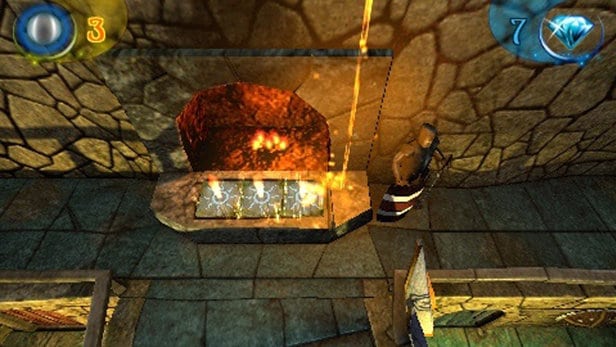You can trust VideoGamer. Our team of gaming experts spend hours testing and reviewing the latest games, to ensure you're reading the most comprehensive guide possible. Rest assured, all imagery and advice is unique and original. Check out how we test and review games here
Before I get into saying anything else about this game, I really must commend the individual who game up with the back story. Presumably the gameplay concept was what came first, and then once everything was all well underway some poor marketing assistant was tasked with giving the whole thing a ‘meaning’ (which, by the way, it doesn’t actually need). The resultant blurb on the back of the box reads like Tolkien on Acid. I won’t spoil it for you, but as far as coming up with justification for why you have to use a beam of light to guide a small orb through various different levels goes, whoever wrote this excelled themselves. I urge you to read the packaging blurb, even if you don’t buy the game, and I further urge you to buy the game anyway so that this first time Lithuanian developer/publisher makes a huge pot of cash and releases far more games, all of which will hopefully have equally entertaining, totally off-the-wall back stories. But enough about the packaging, right? To the gameplay… Many puzzle games make the mistake of trying too hard, and overcomplicating things. Others make things just that little bit TOO simple, with the result that the gameplay quickly becomes boring. Fading Shadows manages to get the balance just about right.
Viewed in isometric 3D, you control a beam of light which you can move around the screen via the analogue stick or d-pad, and with this beam of light you need to guide a small orb safely through each level. Sounds fairly simple so far, right? To make things a little more complex, your beam of light acts basically like a magnet, and the strength of its attraction changes depending on how tight and how wide you make the beam. Then there’s the orb, which has fairly accurate physics, and which can transform into one of three states: metal, wood and glass. Each of these states has certain pros and cons. The wood orb, for instance, floats on water, but starts to burn if your light beam is kept over it for too long. The metal orb is impervious to the heat from the beam, can also be made to jump a short distance into the air but rusts in water, and the glass orb is more heat resistant than the wood, isn’t harmed by water, but can smash if smacked too hard against objects. The properties of each orb are key to solving many of the puzzles that you need to tackle in order to progress to the end of each level.
Also key to getting through each level is the beam, which – like the orb – can also be used to solve various puzzles. In addition to being used to move the orb, the beam can also directly influence the environment. For instance, it can be used to activate heat-sensitive switches, or re-directed via adjustable mirrors.
Some real thought has gone into the design of this game, and it shows. The operation of the beam of light, and the various strengths and weaknesses of the different types of orb are all introduced gradually over the first few levels, and the puzzles themselves, while starting off simple, gradually grow more and more complex, as the levels themselves grow larger and more intricate. The pace of the game though, is extremely languid. As you’re not racing against a clock, the idea instead is to take the time to study each level and overcome the puzzles successfully without destroying too many of your limited supply of orbs. This is also reflected in the musical score, which is an eerie, haunting soundtrack that perfectly matches the pace of the game, and helps to prevent you from getting frustrated when you’re stuck on a particular puzzle.
So far, so good, and in fact there’s not a whole lot to criticise about this little handheld gem. What criticisms there are, are basically technical ones. The semi-automatic camera, for instance, doesn’t always choose the best view of the action, sometimes ending up behind walls, and while this can be rectified manually, it is still nevertheless annoying. Similarly annoying is control of the beam which, at times, seems to get itself ‘hooked’ on a particular piece of scenery – on more than one occasion the beam seemed to get stuck to a wall or a ledge and refused to obey my commands, steadfastly insisting on moving right and left when I was trying to make it move forward or backwards. And finally, some of the puzzles are either a tad obscure to figure out initially, or require some pixel-perfect orb rolling to get the desired result, something which isn’t always easy to do on the PSP’s small screen, particularly with the afore-mentioned intermittent control glitches.
Despite these gripes though, Fading Shadows is still an outstanding little game, and one that’s well suited to the handheld. I fully intend to while away many hours of travelling engrossed in this little gem, and I can heartily recommend it to puzzle game fans everywhere as an example of what video games can be when someone puts a little thought into trying to come up with something original as opposed to churning out just another sequel or licence. That said, I’d probably buy Fading Shadows 2, and after reading the over-imaginative blurb on the back of the box, I would DEFINITELY pay to see a movie based on this licence!

/https://oimg.videogamer.com/images/cc58/fading_shadows_5.jpg)






